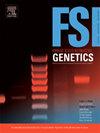基于微生物组抗生素耐药基因的高通量qPCR鉴定体液来源
IF 3.1
2区 医学
Q2 GENETICS & HEREDITY
引用次数: 0
摘要
确定体液的来源是法医调查的关键步骤。近年来,高通量测序技术的发展使得微生物组在法医研究中用于体液鉴定。然而,高通量测序数据难以分析,测序方案复杂。越来越多的研究集中在人类微生物组中的抗生素耐药基因(ARGs)上。定量聚合酶链反应(qPCR)可以检测人体不同部位ARGs的丰度和多样性。迄今为止,还没有研究根据ARGs推断体液的来源。因此,我们尝试使用ARGs作为推断体液来源的工具。我们利用高通量qPCR技术评估了血液、精液、唾液、阴道分泌物、鼻分泌物和粪便样本中64种ARGs的丰度和多样性。结果表明,粪便样品中ARGs的多样性显著高于其他样品类型(P <; 0.05)。主坐标分析(PCoA)表明,样品主要按类型聚类。我们构建了基于64个ARGs的随机森林分类模型,预测精度为92.68 %。接下来,我们评估了随机森林模型中特征的重要性(mean reduction accuracy, MDA)。随后,我们对MDA最高的基因进行排序,构建了前40和20个ARGs的预测模型,预测准确率均为92.68 %。前10位ARGs的准确率为87.80 %。值得注意的是,当仅使用前10个特征ARGs构建唾液、精液和VS样本的模型时,预测准确率达到95.24 %。这表明血液、精液、唾液、NS、VS和粪便样本可以使用ARGs准确识别。我们的结果表明,ARGs是法医体液鉴定的有希望的标记。本文章由计算机程序翻译,如有差异,请以英文原文为准。
Identification of body fluid sources based on microbiome antibiotic resistance genes using high-throughput qPCR
Identifying the origin of body fluids is a critical step in forensic investigation. Recently, the development of high-throughput sequencing technology has led to the use of microbiomes for body fluid identification in forensic studies. However, high-throughput sequencing data are difficult to analyze, the sequencing protocol is complicated. An increasing number of studies have focused on antibiotic resistance genes (ARGs) in the human microbiome. The abundance and diversity of ARGs in different parts of the human body can be detected using quantitative polymerase chain reaction (qPCR). To date, no studies have inferred the sources of body fluids based on ARGs. Therefore, we attempted to use ARGs as a tool to infer the origin of body fluids. We assessed the abundance and diversity of 64 ARGs in blood, semen, saliva, vaginal secretions (VS), nasal secretions (NS), and fecal samples using high-throughput qPCR. The results showed that ARGs were more diverse in fecal samples, which was significantly higher than those of other sample types (P < 0.05). Principal coordinate analysis (PCoA) showed that the samples clustered mainly according to their type. We constructed a random forest classification model based on 64 ARGs with a prediction accuracy of 92.68 %. Next, we evaluated the importance of the features in the random forest model (mean decrease accuracy, MDA). Subsequently, we constructed prediction models for the top 40 and 20 ARGs after sorting genes with the highest MDA, and their prediction accuracies were both 92.68 %. The accuracy of the top 10 ARGs was 87.80 %. Notably, when only the top 10 characterized ARGs were used to construct models for saliva, semen, and VS samples, the prediction accuracy reached was 95.24 %. This shows that blood, semen, saliva, NS, VS, and fecal samples can be accurately identified using ARGs. Our results suggest that ARGs are promising markers for forensic body fluid identification.
求助全文
通过发布文献求助,成功后即可免费获取论文全文。
去求助
来源期刊
CiteScore
7.50
自引率
32.30%
发文量
132
审稿时长
11.3 weeks
期刊介绍:
Forensic Science International: Genetics is the premier journal in the field of Forensic Genetics. This branch of Forensic Science can be defined as the application of genetics to human and non-human material (in the sense of a science with the purpose of studying inherited characteristics for the analysis of inter- and intra-specific variations in populations) for the resolution of legal conflicts.
The scope of the journal includes:
Forensic applications of human polymorphism.
Testing of paternity and other family relationships, immigration cases, typing of biological stains and tissues from criminal casework, identification of human remains by DNA testing methodologies.
Description of human polymorphisms of forensic interest, with special interest in DNA polymorphisms.
Autosomal DNA polymorphisms, mini- and microsatellites (or short tandem repeats, STRs), single nucleotide polymorphisms (SNPs), X and Y chromosome polymorphisms, mtDNA polymorphisms, and any other type of DNA variation with potential forensic applications.
Non-human DNA polymorphisms for crime scene investigation.
Population genetics of human polymorphisms of forensic interest.
Population data, especially from DNA polymorphisms of interest for the solution of forensic problems.
DNA typing methodologies and strategies.
Biostatistical methods in forensic genetics.
Evaluation of DNA evidence in forensic problems (such as paternity or immigration cases, criminal casework, identification), classical and new statistical approaches.
Standards in forensic genetics.
Recommendations of regulatory bodies concerning methods, markers, interpretation or strategies or proposals for procedural or technical standards.
Quality control.
Quality control and quality assurance strategies, proficiency testing for DNA typing methodologies.
Criminal DNA databases.
Technical, legal and statistical issues.
General ethical and legal issues related to forensic genetics.

 求助内容:
求助内容: 应助结果提醒方式:
应助结果提醒方式:


